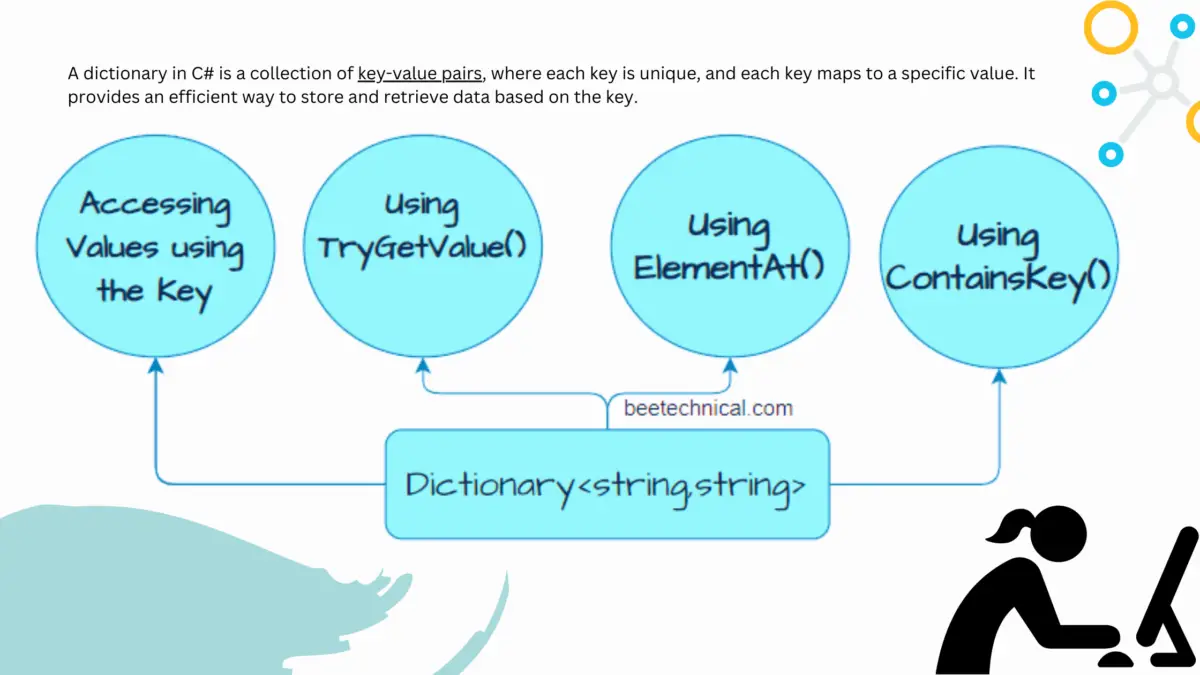In C#, the Guid type represents a globally unique identifier. By default, a Guid cannot be null because it is a value type. However, if you declare a Guid as nullable by appending a question mark ‘?’ after the type, then it can take a null value. e.g., “Guid? myGuid = null;” would assign a null value to the variable “myGuid”.
The Guid struct is a value type in C# and has a default value of all zeroes, which represents an empty Guid. To represent the absence of a value, you can assign a null value to a Guid variable using the nullable type syntax.
Here is an example of declaring a nullable Guid variable:
Guid? nullableGuid = null;
In this case, the nullableGuid the variable is declared as a nullable Guid by appending a ? to the Guid type. This allows the variable to accept a null value, in addition to any valid Guid value.
You can also check if a Guid the variable is null using the Nullable<T>.HasValue property or the null-coalescing operator (??).
Example Program to Implement Nullable Guid in C#
using System;
namespace ConsoleApp1
{
class Program
{
static void Main(string[] args)
{
// Declare a nullable Guid variable
Guid? nullableGuid = null;
// Prompt the user to enter a Guid
Console.Write("Enter a Guid (or press enter to skip): ");
string input = Console.ReadLine();
// Try to parse the input as a Guid
if (!string.IsNullOrEmpty(input))
{
Guid guid;
if (Guid.TryParse(input, out guid))
{
nullableGuid = guid;
}
else
{
Console.WriteLine("Invalid Guid format.");
Console.ReadKey();
return;
}
}
// Display the entered Guid, if any
if (nullableGuid.HasValue)
{
Console.WriteLine("Entered Guid: " + nullableGuid.Value);
}
else
{
Console.WriteLine("No Guid was entered.");
}
// Wait for the user to press a key before closing the console
Console.ReadKey();
}
}
}
What is the default value for Guid?
The default value for a Guid (Globally Unique Identifier) in .NET is a Guid struct initialized to all zeroes. This can be represented in code using the Guid.Empty field, which is a read-only instance of the Guid a struct with all its bytes set to zero.
You can use the Guid.Empty field as a default value for a Guid variable, or you can assign it to a Guid variable to explicitly set it to the default value.
Guid myGuid = Guid.Empty; // sets myGuid to the default value of Guid
It’s important to note that a Guid with all zeroes is not a valid randomly generated GUID, as the chance of generating a Guid with all zeroes is extremely low. In practice, Guid.Empty is typically used to represent a missing or null Guid value, rather than a valid but empty Guid.
How to Check if Nullable Guid is empty in c#?
To check if a nullable Guid the variable is empty or null in C#, you can use the HasValue property or compare it to null.
Here’s an example using the HasValue property:
Guid? nullableGuid = null;
if (!nullableGuid.HasValue)
{
Console.WriteLine("The nullable Guid is empty or null");
}
else
{
Console.WriteLine("The nullable Guid has a value");
}
Alternatively, you can check if the nullable Guid the variable is equal to null, like this:
Guid? nullableGuid = null;
if (nullableGuid == null)
{
Console.WriteLine("The nullable Guid is empty or null");
}
else
{
Console.WriteLine("The nullable Guid has a value");
}
Both of these approaches will produce the same result: checking whether the nullable Guid is empty or null.
What is the difference between UUID and GUID?
UUID (Universally Unique Identifier) and GUID (Globally Unique Identifier) are both unique identifier standards that generate 128-bit values. The main difference between them is their origin and the context in which they are used.
UUID is a standardized format for generating unique identifiers that were originally developed by the Open Software Foundation (OSF). It was later standardized by the Internet Engineering Task Force (IETF) and is commonly used in many different contexts, including software development, network protocols, and database systems. UUIDs are typically generated using a combination of the computer’s network address, the current date and time, and a random number.
GUID, on the other hand, is a Microsoft implementation of the UUID standard. It is used primarily in Microsoft technologies, such as Windows operating systems, .NET Framework, and Microsoft SQL Server. GUIDs are generated in a similar manner to UUIDs, using a combination of the computer’s MAC address, timestamp, and random number. However, the specific algorithm used to generate GUIDs is different from the one used to generate UUIDs.
In practice, UUIDs and GUIDs are very similar and can be used interchangeably in many cases. Both provide a way to generate unique identifiers that are guaranteed to be globally unique, and both use the same 128-bit format. However, because of their different origins and contexts, the terms UUID and GUID are often used to refer specifically to identifiers generated using the UUID or GUID standard, respectively.
How to convert string to Guid in c#?
To convert a string to a Guid in C#, you can use the static Guid.Parse() method or the Guid.TryParse() method.
Here’s an example using the Guid.Parse() method:
string guidString = "6F9619FF-8B86-D011-B42D-00C04FC964FF"; Guid guid = Guid.Parse(guidString);
In this example, the guidString the variable contains the string representation of the Guid value. The Guid.Parse() the method is then used to convert the string to a Guid value, which is assigned to the guid variable.
Alternatively, you can use the Guid.TryParse() method to perform the conversion and handle any errors that may occur if the string is not a valid Guid.
string guidString = "invalid-guid-string";
Guid guid;
if (Guid.TryParse(guidString, out guid))
{
Console.WriteLine("The Guid value is: " + guid.ToString());
}
else
{
Console.WriteLine("The input string is not a valid Guid.");
}
In this example, the Guid.TryParse() method is used to attempt to convert the guidString variable to a Guid value. If the conversion is successful, the guid variable will contain the parsed Guid value. If the conversion fails, the method returns false and the guid variable is left uninitialized.
Conclusion
In this article, we have covered some of the frequently asked questions related to GUID in C#. We have discussed how to generate a GUID and whether it can be null or not. Additionally, we have explained the process of parsing a GUID from a string.
Furthermore, we have also provided a comparison between UUID and GUID, highlighting the differences between the two unique identifier standards.
Overall, this article serves as a helpful guide for anyone looking to work with GUIDs in C#. It covers the basics of generating, parsing, and handling GUIDs, as well as provides context on how GUIDs compare to other unique identifier standards.









Comments are closed.